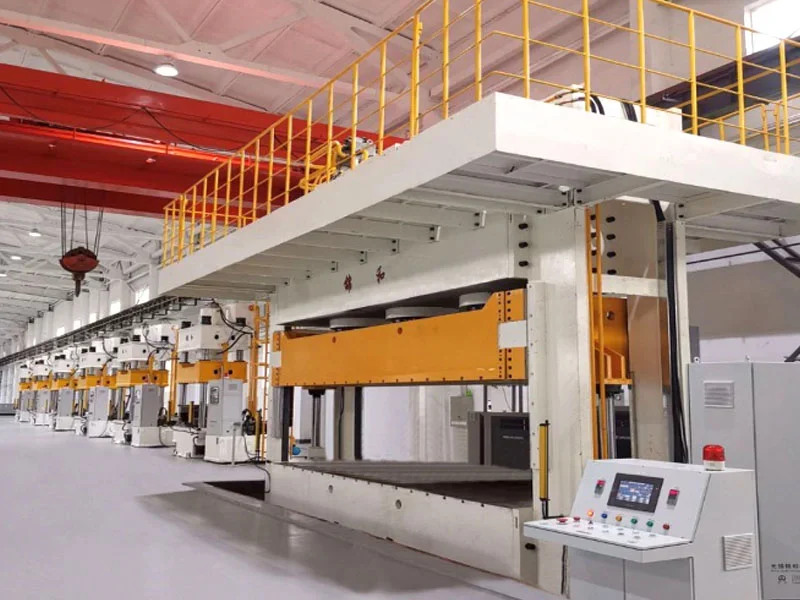Compression moulding presses are versatile machines that can be used for a wide range of materials. From rubber and plastics to composites and even metals, compression moulding presses offer a cost-effective and efficient solution for manufacturing a variety of products. In this article, we will explore the versatility of compression moulding presses and how they can be used for different materials. Whether you are a manufacturer looking to improve your production process or a designer seeking new ways to create innovative products, understanding the capabilities of compression moulding presses is essential. So, let's dive in and discover the many possibilities of this powerful manufacturing technology.
Understanding Compression Moulding and its Benefits
Compression moulding is a manufacturing process that involves the use of a compression moulding press to shape and form materials. This method utilizes heat and pressure to transform raw materials into desired shapes and sizes. One of the key benefits of compression moulding is its ability to create intricate designs with great accuracy, making it ideal for producing complex components.
The process starts by placing a predetermined amount of material, such as plastic or rubber, into a heated mould cavity. The material is then compressed using a hydraulic press, which applies force evenly across the entire surface area of the mould. As heat and pressure are applied, the material softens and takes on the shape of the mould.
One significant advantage of compression moulding is its versatility in working with different types of materials. It can accommodate various thermoplastics, thermosetting plastics, elastomers, composites, and even some metals. This flexibility allows manufacturers to produce an extensive range of products across multiple industries.
Another benefit is that compression moulding offers excellent dimensional stability during production. The combination of heat and pressure ensures consistent part dimensions without warping or distortion. This precision makes compression-moulded parts suitable for applications where tight tolerances are required.
Moreover, this technique eliminates excess waste as any surplus material flows out through vents in the mold during compaction. By minimizing scrap generation, companies can reduce costs associated with raw materials while promoting sustainability in their manufacturing processes.
Understanding how compression molding works opens up countless possibilities for designers and engineers alike when it comes to creating customized components efficiently. Its ability to handle diverse materials combined with superior dimensional stability make it an attractive choice for various industries seeking cost-effective solutions without compromising quality or complexity in their end products.
Types of Materials Used in Compression Moulding
Compression moulding is a versatile manufacturing process that can be used with a wide range of materials. One common material used in compression moulding is thermosetting plastics. These plastics are ideal for this process because they can be easily shaped and molded under heat and pressure, and once cured, they become rigid and durable.
Another type of material commonly used in compression moulding is rubber. Rubber has excellent elasticity and flexibility, making it suitable for creating products such as seals, gaskets, and automotive parts. Additionally, composite materials like carbon fiber reinforced polymers are also compatible with compression moulding presses. These materials offer high strength-to-weight ratios and are commonly used in industries such as aerospace and automotive.
In addition to these materials, compression moulding can also be used with various types of powdered metals to create metal components with complex shapes. This allows manufacturers to produce intricate parts without the need for extensive machining processes.
The versatility of compression moulding presses extends beyond just plastic materials. From thermosetting plastics to rubber compounds to composites and powdered metals, these machines can handle a wide variety of materials to meet the unique needs of different industries. Whether it's creating small precision parts or larger structural components, compression moulding offers endless possibilities for manufacturers seeking efficient production methods.

Applications and Industries that Utilize Compression Moulding
Compression moulding presses are widely used in various industries for their versatility in producing high-quality parts. One of the key applications of compression moulding is in the automotive industry, where it is used to manufacture components such as dashboards, door panels, and interior trim. The ability of compression moulding presses to produce complex shapes with precision makes them ideal for these applications.
Another industry that extensively utilizes compression moulding is the aerospace sector. From aircraft interiors to structural components, compression moulding plays a crucial role in creating lightweight yet durable parts. The process allows engineers to incorporate intricate design features while maintaining strength and reliability.
The electrical and electronics industry also relies on compression moulding for manufacturing insulators, connectors, and other electronic components. With its ability to handle different types of materials like thermosetting plastics or rubber compounds, compression moulding provides excellent insulation properties required by this industry.
Furthermore, the healthcare sector benefits from compression molding technology too. It is commonly used for producing medical devices such as syringe barrels or prosthetic limbs due to its ability to create precise dimensions and meet strict regulatory requirements.
In conclusion,With its wide range of applications across multiple industries, it's clear that compression molding presses offer versatility when it comes to working with different materials. From automotive and aerospace components to healthcare devices and consumer goods – the possibilities are vast! By utilizing this technology effectively while ensuring proper maintenance measures are followed along with adhering strictly safety guidelines; businesses can harness the full potential of compression molding presses. Whether you're looking for strength or complexity in your final product - consider exploring how a quality compressive molding press can enhance your manufacturing process.
Maintenance and Safety Tips for Using a Compression Moulding Press
Proper maintenance and adherence to safety protocols are essential when using a compression moulding press. By following these tips, you can ensure the longevity of your equipment and promote a safe working environment.
Regularly inspect the press for any signs of wear or damage. Check all moving parts, including the platens, hydraulic systems, and electrical components. Replace any worn-out or faulty parts immediately to prevent accidents or breakdowns during operation.
Keep the workspace clean and free from obstructions. Cluttered work areas increase the risk of accidents and can interfere with proper machine functioning. Regularly remove debris, oil spills, or other substances that may pose hazards.
Follow manufacturer guidelines for lubrication. Proper lubrication ensures smooth operation of the press while reducing friction between moving parts. Use only recommended lubricants in appropriate quantities as excessive lubrication can lead to malfunctions.
Train operators on safe operating procedures and provide them with personal protective equipment (PPE). Operators should wear gloves, safety glasses, ear protection if necessary, and follow specific safety instructions provided by manufacturers.
Establish routine maintenance schedules to conduct regular inspections, cleaning sessions, and servicing procedures. Keep detailed records of all maintenance activities performed on each press unit to track its performance over time.
By prioritizing maintenance practices such as inspection routines, cleanliness measures along with training operators properly in safe operating procedures will help optimize productivity while ensuring operator safety in a compression moulding press environment.

Conclusion
In this article, we explore the versatility of compression molding machines for a variety of materials. We’ve seen how compression molding offers numerous advantages, such as cost-effectiveness, high productivity, and superior part quality. It is a manufacturing process widely used in industries such as automotive, aerospace, and electronics.
We also discuss the different types of materials that can be used for compression molding, including thermoplastics, thermosets, rubbers, and composites. Each material has its own unique properties and applications, making it suitable for specific industries.
Additionally, we take an in-depth look at the various applications and industries that utilize compression molding. Whether producing high-precision automotive parts or creating intricate designs in jewelry making, compression molding machines play a vital role in achieving the desired results.
We emphasize the importance of maintenance and safety when using compression molding machines. Regular maintenance ensures optimal performance and extends the life of your equipment, while following safety protocols reduces workplace accidents and injuries.
Clearly, compression molding machines offer tremendous versatility in molding a variety of materials. Able to adapt to different materials and produce complex parts with ease, these machines are essential tools for manufacturers in many industries. By understanding its capabilities and implementing proper maintenance practices and safety guidelines, businesses can take advantage of all the advantages compression molding technology has to offer.








